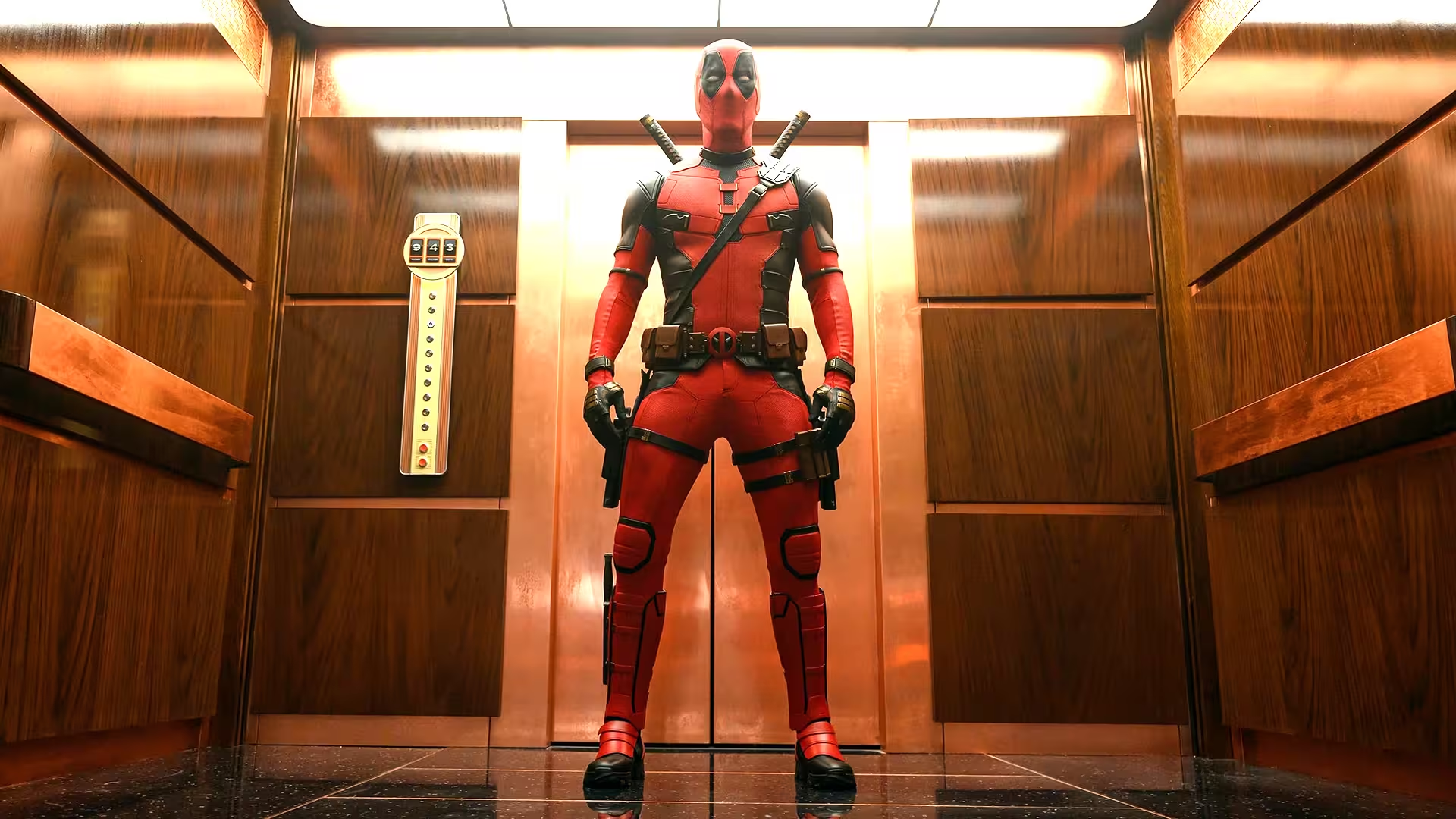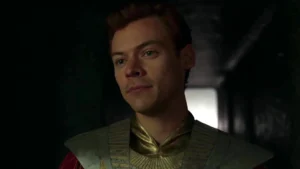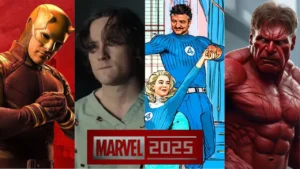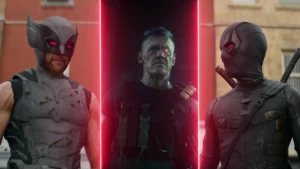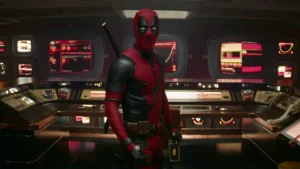Deadpool is one of the most popular superheroes in the comic book world today. But his journey to fame was far from straightforward. Deadpool’s character initially struggled with poor adaptations and was almost sidelined by the very studio that now thrives on his success. Fox didn’t even want to give him his own movie at first, and he was nearly forgotten in the shadows of other more prominent Marvel characters. However, against all odds, Deadpool made a triumphant comeback, revitalizing Marvel and forever altering the superhero genre. Today, we explore the rise, fall, and ultimate resurgence of Deadpool, tracing his journey from comic book pages to big screen triumphs.
Deadpool’s Early Days
Deadpool’s story begins in the early 90s when artist Rob Liefeld first presented the design of this now-iconic character to Marvel Comics. Liefeld, who was also known for his infamous drawing of Captain America, created Deadpool as another edgy anti-hero in a landscape full of similar characters. In his early appearances, Deadpool was far from the groundbreaking figure we recognize today. Instead, he was just another 90s anti-hero with guns, a colorful suit, and a lot of pouches—traits reminiscent of other Liefeld creations like Cable and several Image Comics characters.
Initially, Deadpool also bore a striking resemblance to DC’s Deathstroke, sharing not only similar costumes but also comparable mercenary backgrounds. Despite these unoriginal beginnings, writer Fabian Nicieza approved Liefeld’s design and introduced Deadpool in “New Mutants #98.” In his debut, Deadpool was merely a villain going up against Cable, with no unique attributes like fourth-wall-breaking or connections to other popular Marvel characters like Wolverine. He was just another forgettable villain, with no backstory or intriguing motivations. Deadpool seemed destined to fade away after a few issues, likely to be replaced by yet another generic villain of the 90s.
The Influence of Rob Liefeld and Fabian Nicieza
However, Deadpool managed to stand out, largely due to his sharp humor, which caught the attention of Marvel’s editors. They saw potential in the character and decided to give him a second chance. Deadpool started making brief appearances in “X-Force,” where he clashed with Cable again. During these appearances, Deadpool’s character evolved, becoming funnier and shifting from a villain to an anti-hero—similar to the transformation that occurred with Venom. His origin story was also fleshed out: Wade Wilson was revealed to be a test subject for Weapon X, the same program that gave Wolverine his adamantium skeleton.
Deadpool’s connection with Wolverine led to numerous crossovers, and the duo became one of Marvel’s most beloved pairs. Wade Wilson’s unpredictable and humorous nature set him apart from other Marvel characters, leading many to consider him a Spider-Man for adults, a niche Marvel hadn’t fully tapped into until Deadpool’s rise. Deadpool’s distinct blend of humor, fourth-wall-breaking, and a lack of a strict moral code resonated with fans, setting the stage for his eventual rise to fame.
Deadpool’s Initial Struggles and Rise in Popularity
In the early 90s, the comic book industry was flooded with edgy anti-heroes, and Deadpool initially struggled to find his footing among them. He looked similar to many characters from the time, like Cable and the numerous heroes from Image Comics, who all sported guns, pouches, and attitude. This era was marked by characters who seemed more focused on looking cool than having compelling stories or motivations, and Deadpool was no different at first. To make things worse, Deadpool was often compared to DC’s Deathstroke, as their costumes and mercenary backgrounds were eerily similar.
Despite these initial setbacks, Deadpool’s character began to gain traction thanks to his sharp wit and comedic timing, which made him stand out from the sea of grim and serious anti-heroes of the 90s. As Deadpool made more appearances in “X-Force,” writer Fabian Nicieza took the opportunity to redeem him, transforming Deadpool from a run-of-the-mill villain into a unique anti-hero with a distinct voice and personality. This transformation was crucial in shifting Deadpool’s trajectory from obscurity to prominence.
From Villain to Anti-Hero
Deadpool’s transformation from villain to anti-hero was not an overnight success, but rather a gradual evolution. Initially introduced as a villain in “New Mutants #98,” Deadpool was intended to be just another adversary for Cable. However, as he appeared in subsequent issues, his humorous nature started to shine through, setting him apart from other characters of the time. Deadpool’s humor, which was a mix of dark comedy and self-awareness, quickly became his defining trait. Unlike other characters, he wasn’t confined by the typical moral codes of heroes like Spider-Man or Captain America. He would crack edgy jokes and break the fourth wall, often speaking directly to the readers, which was something rarely seen in comics at the time.
This unique approach not only entertained fans but also allowed writers to experiment with storytelling. Deadpool’s recurring hallucinations and unreliable narration meant that almost any kind of story could be told, with the fallback that it could all just be in his head. This narrative freedom helped solidify his place in Marvel Comics, leading to his first ongoing series in the late 90s, written by Joe Kelly. In this series, Deadpool became more than just a side character; he was now a fully-fledged anti-hero, capable of carrying his own stories and engaging with Marvel’s broader universe.
Unique Identity: Humor, Fourth Wall Breaks, and More
As Deadpool continued to evolve, his creators leaned heavily into his humor and his penchant for breaking the fourth wall, which became his signature traits. Deadpool didn’t just exist within the Marvel universe; he actively commented on it, poking fun at other characters, storylines, and even the very medium of comics itself. This meta-narrative style was groundbreaking and set Deadpool apart as a character who wasn’t afraid to mock the superhero genre, including the often convoluted and self-serious nature of comic book stories.
Deadpool’s humorous approach also extended to his interactions with other characters. He didn’t just fight alongside heroes like Spider-Man or Wolverine; he actively made fun of them, creating a dynamic that was both entertaining and fresh. His interactions often highlighted the absurdity of the situations they found themselves in, and his lack of respect for the traditional hero-villain dichotomy made him a wildcard within the Marvel universe. Deadpool’s unpredictability, combined with his irreverence, solidified his place as a fan-favorite, turning what could have been a forgettable character into one of Marvel’s most enduring anti-heroes.
Deadpool’s Early Adaptations and the Road to Live-Action
Despite his growing popularity in the comics, Deadpool’s journey to live-action was fraught with challenges. Ryan Reynolds, who would later become synonymous with the character, first encountered Deadpool’s potential when he starred in “Blade: Trinity” in 2004. An executive saw Reynolds’ performance and remarked that he was the perfect fit for Deadpool. This marked the beginning of Reynolds’ long connection with the character, one that would face numerous setbacks before finally finding success.
Deadpool’s first live-action appearance came in “X-Men Origins: Wolverine” (2009), but it was far from the adaptation fans hoped for. Reynolds was cast as Wade Wilson, but the character was drastically altered for the film’s third act, where Deadpool was turned into Weapon 11, a mute, heavily modified mutant with a blend of various powers, and katanas embedded in his arms. This version of Deadpool was a far cry from the wisecracking, fourth-wall-breaking anti-hero fans loved. Reynolds himself expressed concerns about the portrayal, famously warning the studio that fans would react negatively. Despite his reservations, Reynolds took the role, believing it was his only chance to bring Deadpool to life, even if it wasn’t the version he had envisioned.
Ryan Reynolds: The Perfect Fit for Deadpool
Ryan Reynolds’ passion for Deadpool was evident even before he fully embodied the character in his own solo film. After his disappointing appearance in “X-Men Origins: Wolverine,” Reynolds continued to lobby for a proper adaptation of Deadpool. His dedication stemmed from his deep connection to the character; Reynolds often described how Deadpool’s irreverent humor and carefree attitude mirrored his own personality. This connection was even reflected in the comics, where Deadpool once quipped that he looked like “Ryan Reynolds crossed with a Shar-Pei.” Reynolds saw this as a sign that he was destined to play the role.
Despite the initial setback in “X-Men Origins: Wolverine,” Reynolds remained determined. He spent years pitching a standalone Deadpool movie that would stay true to the character’s comic roots. His persistence paid off when test footage for a proposed Deadpool film leaked in 2014. The footage, which showcased a fully CGI Deadpool voiced by Reynolds, breaking the fourth wall and displaying all the comedic violence fans expected, went viral. The overwhelmingly positive response from fans forced Fox to reconsider, ultimately greenlighting the project. This was a pivotal moment for Deadpool, proving that a faithful adaptation could succeed.
X-Men Origins: Wolverine – A Misstep for Deadpool’s Character
“X-Men Origins: Wolverine” was intended to be a stepping stone for Deadpool’s character, but it ended up being one of the most criticized portrayals of a comic book character in recent history. The film presented a version of Deadpool that was unrecognizable to fans—his trademark humor was gone, his iconic costume was replaced by a bizarre, muted look, and most controversially, his mouth was sewn shut, rendering him unable to speak. This was a baffling choice, as Deadpool is famously known as the “Merc with a Mouth.”

The decision to alter Deadpool so drastically was emblematic of Fox’s broader approach to the X-Men franchise at the time, where creative liberties often led to significant deviations from the source material. While Wolverine thrived under these conditions, Deadpool suffered, and the backlash was immediate. Fans were vocal in their disapproval, and Reynolds himself acknowledged that the portrayal was not what he or the fans wanted. The critical and fan response to this version of Deadpool was so negative that it nearly derailed any future prospects for a standalone movie. However, the character’s popularity in the comics and Reynolds’ commitment kept the dream alive, setting the stage for Deadpool’s eventual redemption on the big screen.
Deadpool’s Redemption
After the disastrous portrayal in “X-Men Origins: Wolverine,” it seemed like Deadpool’s future in live-action was uncertain. However, Deadpool’s popularity in other media kept the character alive and relevant. In 2011, Marvel released “Deadpool Kills the Marvel Universe,” a comic series that saw Deadpool take on and kill some of the most iconic characters in Marvel’s roster. Though it wasn’t part of the main continuity, the series became a massive hit, attracting both long-time fans and newcomers. It proved that Deadpool still had a dedicated following, and that there was a strong appetite for stories featuring his unique brand of humor and violence.
Following the success of the comic, Deadpool continued to make waves in the video game world. In 2012, High Moon Studios released a “Deadpool” video game published by Activision. This game was Marvel’s attempt to replicate the success of DC’s Batman Arkham series, and although the gameplay received mixed reviews, the portrayal of Deadpool was widely praised. The game stayed true to the character, filled with fourth-wall breaks, meta-humor, and numerous cameos from other Marvel characters, including Cable, Wolverine, and the X-Men. The game demonstrated that when Deadpool is handled correctly, his chaotic and comedic nature can translate well to different formats. Unfortunately, due to licensing issues, the game became difficult to access legally after its release, limiting its long-term impact.
Deadpool also found success in animation. He co-starred in an episode of “Ultimate Spider-Man,” a popular animated series aimed at younger audiences. Despite the show’s target demographic, the episode featuring Deadpool was one of the most watched and best-rated of the series. Even though some of Deadpool’s more mature humor had to be toned down, the essence of the character remained intact, proving that Deadpool could appeal to a wide range of audiences. This consistent popularity across various media reaffirmed that Deadpool had the potential for a successful live-action comeback.
Deadpool’s First Solo Film
The turning point for Deadpool’s character came when Fox finally greenlit a standalone movie. This breakthrough was largely driven by the overwhelming fan reaction to the leaked test footage in 2014, which perfectly captured Deadpool’s comic book persona. Ryan Reynolds was officially back as the lead, this time with full creative control alongside director Tim Miller and the writing team from “Zombieland.” Despite the excitement, Fox executives remained skeptical, granting the movie a modest budget of $58 million—a fraction of what other superhero films were receiving at the time.

Released in 2016, “Deadpool” defied all expectations. The movie was a faithful adaptation of the character, complete with his trademark humor, fourth-wall breaks, and brutal action sequences. Despite its lower budget, the film excelled in delivering on the fan’s expectations, using clever writing and innovative direction to create a fresh, entertaining experience. The costume design was spot-on, the CGI for characters like Colossus was impressive, and the film’s irreverent tone resonated deeply with audiences. Reynolds’ portrayal of Deadpool was universally praised, as he effortlessly embodied the character’s wit and chaotic energy.
The movie’s success was undeniable. “Deadpool” grossed $782 million worldwide, making it the highest-grossing R-rated movie at the time and the most successful film in Fox’s X-Men universe. Its success not only redeemed the character in the eyes of fans but also proved that superhero films could thrive outside the conventional PG-13 formula. “Deadpool” broke new ground, paving the way for future adult-oriented superhero content and solidifying Deadpool as a major player in the superhero genre.
Deadpool 2
With the overwhelming success of the first film, a sequel was inevitable. “Deadpool 2,” released in 2018, saw an increased budget of $110 million, allowing for more elaborate action sequences, higher-quality special effects, and an expanded cast of characters. The film introduced Josh Brolin as Cable, a time-traveling mutant and one of Deadpool’s most iconic partners from the comics. Zazie Beetz was cast as Domino, whose luck-based powers added a new dynamic to the action scenes. The sequel also featured several X-Force members, further expanding Deadpool’s universe and connection to the broader X-Men lore.
“Deadpool 2” maintained the humor and irreverence of its predecessor while diving deeper into Deadpool’s character. The film explored themes of family and redemption, wrapped in a typically chaotic Deadpool fashion. It included more elaborate jokes, such as mocking the DC Universe’s darker tone, ribbing Marvel’s own inconsistencies, and even taking shots at Fox’s history of poorly received adaptations. The sequel also retained its meta-commentary on the superhero genre, making fun of everything from lazy storytelling tropes to the overly serious nature of some superhero films.
Despite the increased scope, “Deadpool 2” stayed true to the essence of the character and was well-received by both critics and audiences. It grossed $785 million, slightly outdoing the first film and solidifying Deadpool’s place as a box-office powerhouse. The success of “Deadpool 2” demonstrated that the character was not a one-hit wonder but rather a sustainable franchise capable of evolving while retaining its core appeal.
Deadpool in the MCU
The success of “Deadpool” and “Deadpool 2” set the stage for even bigger possibilities, especially after Disney acquired Fox in 2019, gaining control of the X-Men and related characters, including Deadpool. This acquisition raised questions about Deadpool’s future, as the Marvel Cinematic Universe (MCU) had a more family-friendly reputation compared to the R-rated antics of Deadpool. However, Marvel Studios head Kevin Feige reassured fans that Deadpool would maintain his R-rating, making him the only MCU project with such a distinction.

The integration of Deadpool into the MCU posed unique challenges. While fans eagerly anticipated the character’s interaction with the Avengers, the studio wanted to ensure that Deadpool’s irreverent tone would not clash with the broader MCU. Ryan Reynolds was heavily involved in the development process, submitting numerous drafts to Feige, each exploring different storylines and budget options. However, finding the right fit took time, and Deadpool’s entry into the MCU was delayed as Marvel carefully plotted the future of their franchise.
A major breakthrough came when Reynolds managed to convince Hugh Jackman to reprise his role as Wolverine for “Deadpool 3.” Jackman had previously retired the character after the critically acclaimed “Logan,” but the idea of teaming up with Deadpool proved too enticing. Reynolds and Jackman’s off-screen friendship mirrored the on-screen dynamic between Deadpool and Wolverine, making this collaboration a perfect fit. With Jackman on board, “Deadpool 3” promised to deliver an epic crossover, blending the chaotic humor of Deadpool with Wolverine’s gruff demeanor. This move not only excited long-time fans of both characters but also hinted at the potential for Deadpool to play a significant role in the MCU’s future, especially with upcoming multiverse storylines.
Bringing Hugh Jackman’s Wolverine Back for Deadpool 3
Getting Hugh Jackman to return as Wolverine was a game-changer for “Deadpool 3.” Jackman’s Wolverine had been a cornerstone of Fox’s X-Men franchise, and his final appearance in “Logan” was widely regarded as a perfect farewell. However, the idea of pairing Wolverine with Deadpool was irresistible, both for fans and the actors themselves. Reynolds and Jackman had a natural chemistry, and their friendly rivalry and banter off-screen translated into a perfect dynamic on-screen.

Initially, Marvel Studios was hesitant to bring Jackman back, concerned that it might undermine the emotional impact of “Logan.” However, Jackman was eager to explore the character in a new light, particularly in the comedic, fourth-wall-breaking world of Deadpool. The creative team behind “Deadpool 3” embraced this opportunity, crafting a story that would honor the legacy of Wolverine while allowing for the irreverent fun that defines Deadpool. The film was set to explore themes of legacy and friendship, with Deadpool and Wolverine navigating the complexities of the multiverse together.
The announcement of Jackman’s return, accompanied by a teaser video featuring Reynolds and Jackman, sent fans into a frenzy. It was a dream pairing that many thought they would never see, and it promised to deliver the perfect blend of action, humor, and heart. “Deadpool 3” was no longer just a continuation of Deadpool’s story; it was a celebration of two iconic characters and their enduring popularity in the superhero genre.
Deadpool and Wolverine: Breaking the Box Office
The marketing campaign for “Deadpool and Wolverine” was nothing short of spectacular. Reynolds and Jackman played off each other brilliantly, teasing fans with humorous videos and creative promotional stunts. From changing the movie’s title just to mess with Deadpool, to collaborations with brands like Heineken, where Deadpool humorously took away Logan’s claws, the marketing strategy was a masterclass in building hype. Fans eagerly speculated about potential cameos, plot twists, and how the film would handle the blending of the Deadpool and X-Men universes within the larger MCU framework.
Upon its release, “Deadpool and Wolverine” delivered exactly what fans had hoped for. The film retained the irreverent tone and meta-humor of its predecessors while exploring the dynamic between Deadpool and Wolverine in a way that was both entertaining and meaningful. The movie included numerous cameos that added depth and humor to the story, from poking fun at the power hierarchy in the DC universe to addressing the lingering issues from Fox’s X-Men continuity. It also didn’t shy away from making jabs at the current state of the MCU, particularly the complexities and inconsistencies of the multiverse.
“Deadpool and Wolverine” quickly became a box office sensation, surpassing the billion-dollar mark and becoming one of the highest-grossing films of the year. It was a testament to the enduring popularity of both characters and the success of blending their worlds. The film’s impact extended beyond just financial success; it reaffirmed the viability of R-rated superhero films in a landscape dominated by more family-friendly offerings. The success of “Deadpool and Wolverine” solidified Deadpool’s place as a major player in the MCU and hinted at even more ambitious crossovers in future Marvel projects.
Conclusion: Deadpool’s Legacy in the Superhero Genre
Deadpool’s journey from a marginal comic book character to one of the most beloved superheroes in popular culture is a testament to the character’s unique appeal and the relentless dedication of Ryan Reynolds. From his early days as a minor villain in the Marvel Universe, Deadpool has evolved into a cultural icon, reshaping the superhero genre with his irreverence, humor, and willingness to subvert traditional storytelling norms. His rise, fall, and eventual resurgence exemplify how a character that defies conventions can resonate deeply with audiences, providing a fresh and entertaining perspective on the often formulaic superhero landscape.
Deadpool’s success has also had a broader impact on the genre. The unexpected triumph of his R-rated movies paved the way for other mature and unconventional adaptations, such as “The Boys,” “The Umbrella Academy,” and even DC’s “Doom Patrol.” These projects, like Deadpool, challenge the norms of superhero narratives, offering more complex, satirical, and often darker takes on the genre. Deadpool’s ability to break the fourth wall and poke fun at the superhero genre itself has opened the door for more self-aware and subversive storytelling in mainstream comic book adaptations.
Deadpool’s Role in Changing the Superhero Landscape
Deadpool’s influence extends beyond his own films; he has fundamentally changed the way studios approach superhero movies. By proving that audiences are receptive to more mature, R-rated content, Deadpool has encouraged studios to take risks with properties that might have otherwise been sidelined or watered down to appeal to broader demographics. The success of Deadpool demonstrated that there is a substantial audience for content that pushes boundaries, both in terms of humor and storytelling. This shift has allowed for more diverse voices and styles within the superhero genre, moving beyond the traditional PG-13 framework that dominated the early 2000s.
Additionally, Deadpool’s success has emphasized the importance of authenticity and faithfulness to source material. Fans’ positive reception of the character was largely due to how closely Ryan Reynolds and the creative team adhered to the essence of Deadpool from the comics. This fidelity to the character’s roots, combined with a willingness to innovate and take risks, has set a new standard for comic book adaptations. Deadpool’s journey has shown that honoring the original spirit of a character can lead to both critical and commercial success, reinforcing the idea that superhero stories can be both true to their origins and innovative.
The Future of Deadpool: What’s Next?
Looking ahead, the future of Deadpool within the MCU appears promising. With the success of “Deadpool and Wolverine,” it is clear that the character still has a significant role to play in Marvel’s evolving cinematic universe. Although Deadpool and Wolverine didn’t fully integrate into the MCU’s main continuity by the end of their film, there are strong indications that both characters will continue to be featured in future projects, potentially including major crossover events like “Secret Wars.” The blend of Deadpool’s chaotic energy with the more structured world of the MCU presents numerous opportunities for unique storytelling and character interactions.
Moreover, Ryan Reynolds’ commitment to the character and his ongoing involvement in the creative process ensures that Deadpool will remain true to the elements that made him a fan favorite. As the MCU continues to explore the multiverse, there are endless possibilities for Deadpool’s involvement, from interacting with characters like Spider-Man and the Avengers to even crossing paths with more obscure Marvel heroes. The potential for humor, meta-commentary, and breaking the fourth wall in these interactions is vast, promising continued entertainment for fans old and new.
Ultimately, Deadpool’s legacy is one of resilience, creativity, and the power of staying true to a character’s core identity. From overcoming disastrous adaptations to redefining what a superhero movie can be, Deadpool’s journey is a remarkable story of triumph against the odds. As the character continues to evolve and carve out his place within the broader Marvel Cinematic Universe, one thing is certain: Deadpool is here to stay, and his impact on the superhero genre will be felt for years to come.

